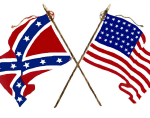Welcome to this Special Projects site of the TNGenWeb Project

TENNESSEE AND SECESSION
In 1859 a man by the name of John Brown* whose home was in Kansas came to Harper’s Ferry, Virginia (now West Virginia) for the purpose of organizing the slaves and furnishing them with firearms. The capture of the federal arsenal in Harper’s Ferry and the execution of John Brown was a major turning point in the American abolitionist movement. These actions encouraged peaceful abolitionists to accept more militant measures to push for the end of slavery.
They were already excited on the question and this tended to drive them to extreme measures of precaution. The state of the public mind was shown in the nomination made for president of the United States in 1860. The people both North and South were so hopelessly divided that they put four different presidential tickets in the field.
Lincoln’s election by the Northern states alone, together with John Brown’s raid the year before, was construed by many Southern men to mean that the North, through the new administration was going to abolish slavery, whatever danger or hardship it might bring to the South. Some of the Southern states felt that their interests were no longer safe in the Federal government, decided to withdraw from the Union.
Tennessee refused to withdraw from the Union although it asserted that they had the constitutional right to withdraw. They felt that it would be much better for all if the slave problem could be solved without breaking the Union. Isham G Harris was governor of Tennessee at the time and he was strongly in favor of secession. He called an extra session of the legislature in December, 1860, just after Lincoln’s election for the purpose of considering the question of secession. The legislature met on January 7th, 1861 and arranged for the people of Tennessee to vote on the question of calling a convention to consider secession, and for electing delegates to this convention. The date of the election was fixed for February 9th and on that date the election was held. The result was that Tennessee voted overwhelmingly against secession. The majority for the Union in this election was 64,914. Davidson County gave a majority of 2,548 against secession and Shelby County in West Tennnessee gave a majority of 5,492 against secession. In Shelby County only 197 votes were cast for secession. Knox County cast more votes against the Union than did Shelby. The majority for the Union in this election in Middle Tennessee and West Tennessee was 38,582. So in February, 1861, after several Southern states had withdrawn from the Union, the great majority of the people of Tennessee were opposed to secession.
After South Carolina had withdrawn from the Union she asked the Federal government to withdraw these soldiers from her borders. This the government refused. The result was that on April 12th, 1861 these United States soldiers were bombarded by some Confederates. On this day was fired the first gun of the Civil War. Three days later, on the 15th of April, President Lincoln called for 75,000 soldiers to put down all resistance to national authority and to force back into the Union all the states that had seceded. Tennessee was called upon to furnish a portion of the troops.
Immediately after the president’s proclamation another election was called in Tennessee to vote again on the question of secession. The election was held on June 8th, 1861. This time the vote for secession was 104,913 and the vote against secession was 47,238. In East Tennessee the vote was 34,023 against secession and 14,829 for secession. In the election held in February of this year there was not much difference in sentiment on the question of secession in East Tennessee, Middle Tennessee, and West Tennessee, but in June, Middle Tennessee and West Tennessee voted overwhelmingly for secession and East Tennessee voted more than two to one for the Union.
(Source:A School History of Tennessee, Gustavus W. Dyer, National Book Company, 1919)Available on Google Books Link
*”Captain Brown urged us both to go with him but I could not do so and could but feel that he was about to rivet the fetters more firmly than ever on the limbs of the enslaved.”
“Here we separated they to go to Harper’s Ferry, I to Rochester.” (Source:John Brown, William Edward Burghardt Du Bois, G. W. Jacobs, 1909, P. 297
My notes: Although more people in East Tennessee opposed secession , East Tennessee furnished many men for the Confederacy, and some men from Middle and West Tennessee made their way to Kentucky to join the Union forces. Brother against brother was not just a slogan, in some cases this was literally true.
During the Civil War, many battles were fought in the state of Tennessee. Large battles in the state included the Battle of Shiloh, at battles at Stone River, Chattanooga, Nashville, and Franklin. Tennessee was the last state to secede from the Union on May 17, 1861. The state was the first state to be readmitted to the Union on July 24, 1866.
The goal of this site is to provide information and records that may aid your Tennessee-related Civil War research.